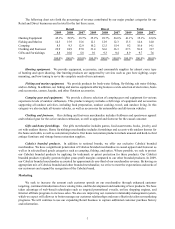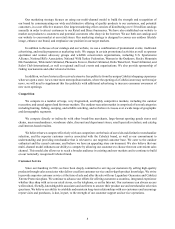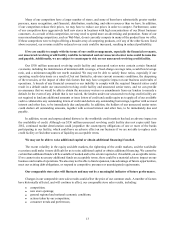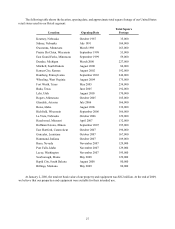Cabela's 2009 Annual Report Download - page 26
Download and view the complete annual report
Please find page 26 of the 2009 Cabela's annual report below. You can navigate through the pages in the report by either clicking on the pages listed below, or by using the keyword search tool below to find specific information within the annual report.17
We cannot predict when, or the extent to which, the countries in which our products are manufactured will
experience any of the above events. Any event causing a disruption or delay of imports from foreign locations would
likely increase the cost or reduce the supply of merchandise available to us and would adversely affect our operating
results, particularly if imports of our Cabela’s branded merchandise were adversely affected as our margins are
higher on our Cabela’s branded merchandise.
In addition, trade restrictions, including increased tariffs or quotas, embargoes, safeguards, and customs
restrictions against apparel items, as well as United States or foreign labor strikes, work stoppages, or boycotts could
increase the cost or reduce the supply of merchandise available to us or may require us to modify our current business
practices, any of which could hurt our profitability.
Due to the seasonality of our business, our annual operating results would be adversely affected if our
revenue during the fourth quarter was substantially below expectations.
We experience seasonal fluctuations in our revenue and operating results. Historically, we have realized a
significant portion of our revenue and earnings for the year in the fourth quarter. In 2009 and 2008, respectively,
we generated 34.9% and 34.5% of our revenue, and 33.5% and 64.7% of our net income, in the fourth quarter. We
incur significant additional expenses in the fourth quarter due to higher customer purchase volumes and increased
staffing. If we miscalculate the demand for our products generally or for our product mix during the fourth quarter,
our revenue could decline, which would harm our financial performance. In addition, abnormally warm weather
conditions during the fourth quarter can reduce sales of many of the products normally sold during this time period
and inclement weather can reduce store traffic or cause us to temporarily close stores causing a reduction in revenue.
Because a substantial portion of our operating income is derived from our fourth quarter revenue, a shortfall in
expected fourth quarter revenue would cause our annual operating results to suffer significantly.
If we lose key management or are unable to attract and retain the talent required for our business, our
operating results could suffer.
Our future success depends to a significant degree on the skills, experience, and efforts of our senior executive
management and merchandising teams. With the exception of our Chairman, Richard N. Cabela, our Vice Chairmen,
James W. Cabela and Dennis Highby, and our President and Chief Executive Officer, Thomas L. Millner, none of
our senior management or directors has employment agreements other than our Management Change of Control
Severance Agreements. We do not carry key-man life insurance on any of our executives or key management
personnel. In addition, our corporate headquarters is located in a sparsely populated rural area which may make it
difficult to attract and retain qualified individuals for key management positions. The loss of the services of any of
these individuals or the inability to attract and retain qualified individuals for our key management positions could
cause our operating results to suffer.
Our business depends on our ability to meet our labor needs, and if we are unable to do so, our retail store
expansion strategy may be delayed and our revenue growth may suffer.
Our success depends on hiring, training, managing, and retaining quality managers, sales associates, and
employees in our retail stores and customer care centers. Our corporate headquarters, distribution centers, return
center, and some of our retail stores are located in sparsely populated rural areas. It may be difficult to attract and
retain qualified personnel, especially management and technical personnel, in these areas. Competition for qualified
management and technical employees could require us to pay higher wages or grant above market levels of stock
compensation to attract a sufficient number of employees. If we are unable to attract and retain qualified personnel as
needed, the implementation of our retail store expansion strategy may be delayed and our revenue growth may suffer.
A natural disaster or other disruption at our distribution centers or return facility could cause us to lose
merchandise and be unable to effectively deliver to our direct customers and retail stores.
We currently rely on distribution centers in Sidney, Nebraska; Prairie du Chien, Wisconsin; and Wheeling,
West Virginia, to handle our distribution needs. In addition, on January 1, 2010, we opened a small distribution
center in Winnipeg, Manitoba. We operate a return center in Oshkosh, Nebraska; and our Wheeling, West Virginia,
























